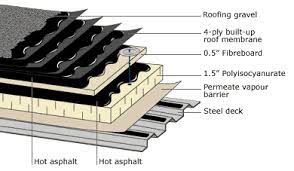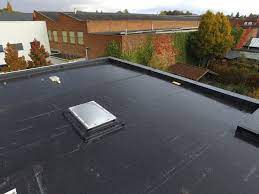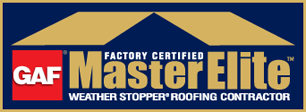Date: September 2022
Before making the decision to have a flat roof installed, you should think about which type of flat roof system is right for your home. Below, you will find information about the three most popular types of flat roofs that are being installed today: Built up Roofs or BUR, Modified Bitumen Roofs, and Rubber Membrane Roofs.
Built Up Roofs (BURs)
A BUR, also sometimes referred to as a tar and gravel roof, is one of the most affordable flat roofing systems on the market today. They are usually made of three of more layers of waterproof ply sheets sandwiched between layers of hot tar. For reliability and durability, these roofing layers are then backfilled with a layer of smooth gravel or river rock.

Pros
Cons
- BUR is a time-tested technology, it has been around for more than 100 years, and the same installation process is still followed, the only difference is the advancement of the waterproofing membranes used.
- Gravel is a great fire retardant
- has a nice, finished look from windows or decks that overlook
- BURs are very heavy and sometimes require that joists be strengthened to ensure stability in the roof
- Tar and gravel systems smell bad and can be a very messy installation process
- BURs are not recommended for homes and are mostly installed on garages
Modified Bitumen Roofs
Modified Bitumen (Mod-bit) roofing is an asphalt-based roofing system that is similar to BUR. They are made of asphalt rolls that are typically 3 feet wide, but a modified bitumen system only uses two layers, a base sheet and a cap sheet. Mod-bit can be installed in four ways: applied with hot tar, cold applied solvent based adhesives, torch down with an open flame to melt the sheets together, and peel and stick base sheets that self adhere when a release tape is removed.

Pros
Cons
- Peel and Stick materials are very user friendly and can even be a DIY project, given the right directions
- It is a light-coloured surface (usually grey or white) that reflects heat and can cut energy costs
- Torch-down application methods are a fire hazard and not always recommended
- It is not as tough as a BUR system would be and is less resistant to tears
Rubber Membrane Roofs
Rubber membrane roofs are easy to spot and are generally installed in one of two ways. Either backfilled or weighed down with larger river rocks or adhered/glued down. Rubber roofs that are glued or adhered are typically black in colour and stretched over an insulation or fibre board. Backfilled rubber roofs, like BURs, are covered in rock, however the stones are usually larger and not adhered to the roof with tar. The rubber membrane can be exposed by gently moving the stones around.

Pros
Cons
- Relatively easy installation process
- Very resistant to cuts and tears while remaining light
- Leaks are easy to identify
- Vulnerable to punctures
- Standard black colour absorbs heat, however lighter coatings can cost approximately 30% more

